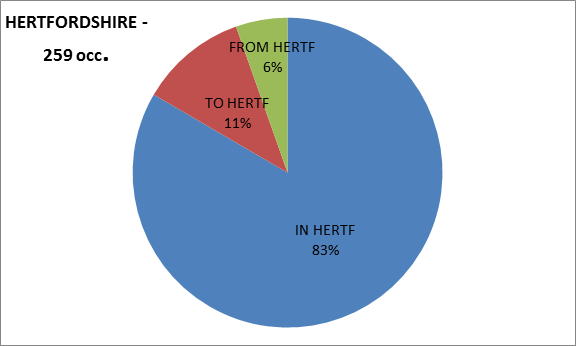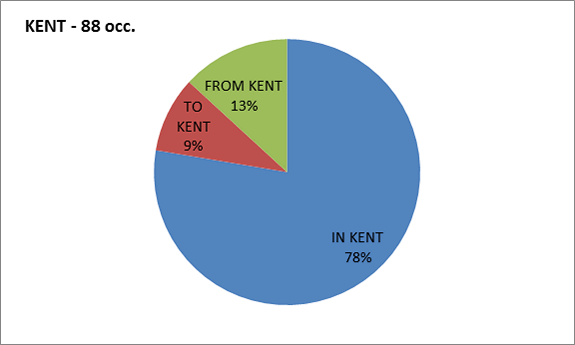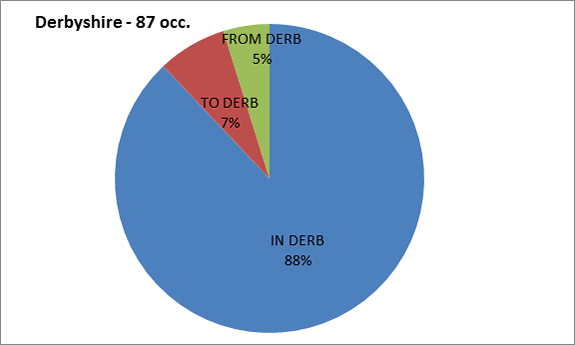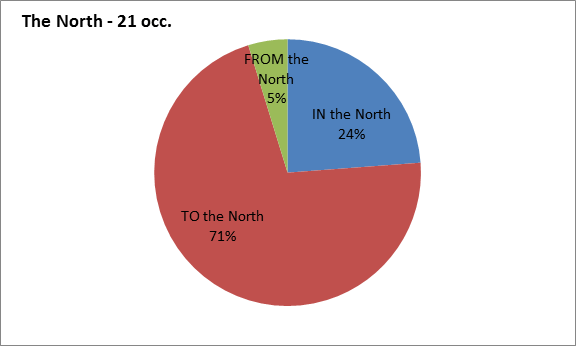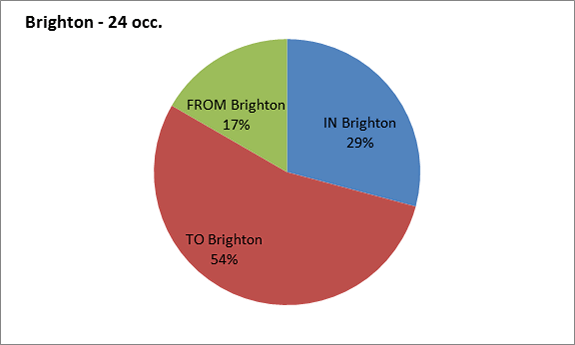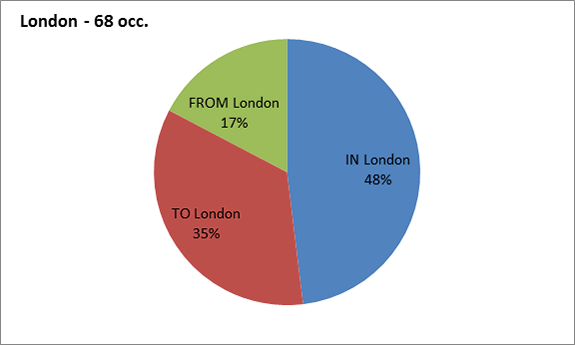Space and Emotions
The use of Toponyms in Pride and Prejudice
1. Space and Emotions
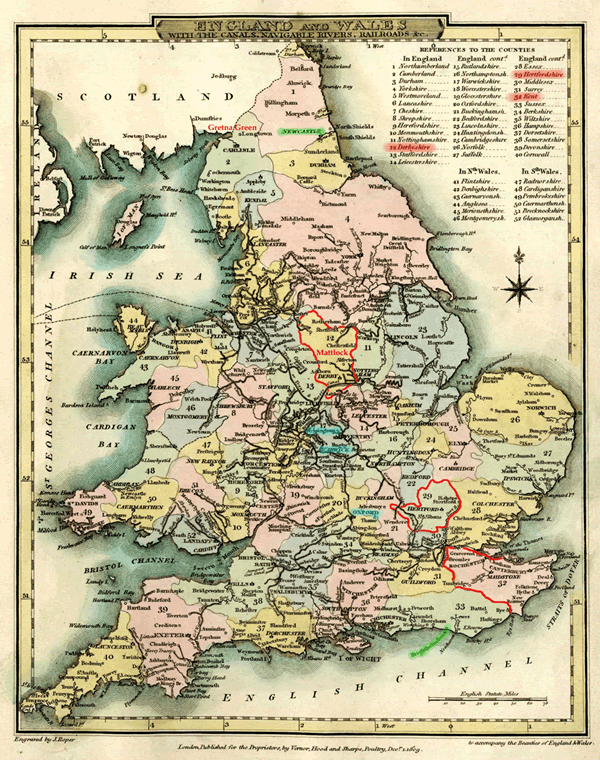
- Maps of England and Wales
- The British Atlas; comprising a complete set of county maps, of England and Wales
London: Printed for Vernor, Hood, and Sharpe; [and 9 others], 1810 Box Collection; by permission of the Warden and Fellows of Winchester College.
[click on the picture to enlarge it]
In The Atlas of the European Novel, Franco Moretti situates on a map of England the places where Austen’s novels begin and end, and where “narrative complications” develop (21) [1]. “Austen’s England; what an invention,” he states, providing similar maps for Amelie Opie’s Adeline Mowbray and Walter Scott’s Ivanhoe. With Austen, “the novel functions as the symbolic form of the nation-state […] it’s a form that (unlike an anthem or a monument) not only does not conceal the country’s internal divisions, but manages to turn them into a story,” thanks to “a field of narrative forces, whose reiterated interplay defines the nation as the sum of all its possible stories: London, or the painful complications of life; the countryside, or the peace of closure; the seaside, and illicit emotions; Scotland, for secret lovers […] (20). Robert Clark has also mapped two of Austen’s novels for the Mapping Writing project.
Using computer-aided textual analysis, one can have an inside view of the way in which Austen organizes the small world of Pride and Prejudice spatially to tell the story of six young women (five sisters and their friend) and five young men ending with four marriages and a balance between the two terms of the title [2]. Stasis and movement within and between six geographical areas show the development of emotions through motion, the interactions between “mobility and interiority.” [3]
2. Places & Spaces
Pride and Prejudice takes place in six major areas: three counties, Hertfordshire, Kent and Derbyshire, two cities, London and Brighton, and a vaguer geographical entity, “the North”. From concordances, graphs and charts, established with the computer programs Hyperbase and Excel, the development of plot and characters is analysed through the use of toponyms or place names. They can also be visualised on an 1810 map of Great Britain.
A General view:
Distribution of toponyms
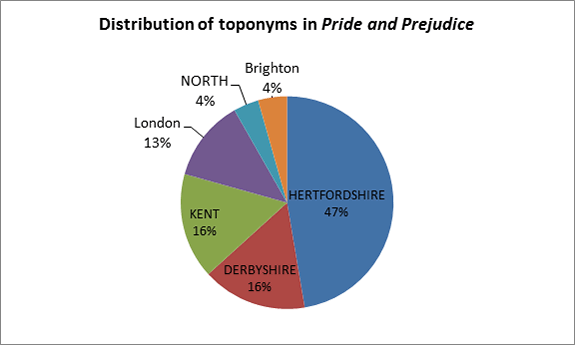
- GRAPH 1 (Excel) - Distribution of toponyms in Pride and Prejudice
- [click on the picture to enlarge it]
This graph, established from Chart 1, shows the proportion of each of the six areas. Areas in capital letters group several place names and London takes the mention of streets into account. Mentions of Hertfordshire make up nearly half of the whole, Kent and Derbyshire are equivalent in terms of quantity, while Brighton and “the North” play a role more important qualitatively than quantitatively.
| Vol I | Vol II | Vol III | |||
| 259 | Hertfordshire | 259 | 113 | 69 | 77 |
| 87 | Derbyshire | 87 | 12 | 20 | 55 |
| 88 | Kent | 88 | 15 | 61 | 12 |
| 68 | London | 68 | 15 | 21 | 32 |
| 21 | North | 21 | 2 | 8 | 11 |
| 24 | Brighton | 24 | 0 | 11 | 13 |
| 547 | Total toponyms | 157 | 190 | 200 | |
| Tokens | 42763 | 35030 | 48545 | ||
| % tokens | 0,37% | 0,54% | 0,41% | ||
- Hertfordshire: Hertfordshire, Longbourn, Meryton, Netherfield
- Derbyshire : Derbyshire, Lambton, Pemberley
- Kent : Kent, Hunsford, Rosings
- London : London, Cheapside, Grace-church street, Grosvenor street, Edward-street, --- street.
- North : north, northern, northward, Newcastle, the Lakes.
- Brighton: Brighton.
Cumulative view of toponyms
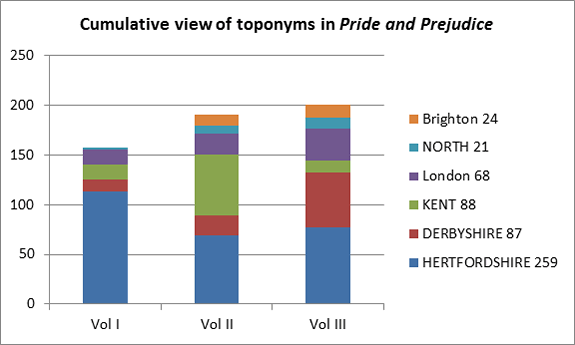
- GRAPH 2 (Excel): Toponyms in the 3 volumes of Pride and Prejudice – Cumulative View
- [click on the picture to enlarge it]
Graph 2 – This cumulative graph shows the differences in the use of place names in the three volumes of Pride & Prejudice: mostly Hertfordshire in volume I with the lowest number (157), mainly Hertfordshire and Kent in volume II (190 place names), the latter being replaced by Derbyshire in volume III (200 place names). Austen uses toponyms with a fairly constant ratio: the proportion varies from 3.7 for every 1,000 words in volume I to 5.4 in volume II where most travelling occurs, and down to 4.1 in volume III. London, Brighton and the North are the least mentioned.
The county of Hertfordshire is the primary location in more senses than one: the story begins there, the first volume mainly unfolds within it, and it is home to the Bennet family. It constitutes, therefore, the place which the girls, aged 15 to 22, must leave so as to mature into women. Toponyms related to it make up the majority of place names (47% of the 547 place names considered). Several locations are named in Hertfordshire and the county is also considered as a whole:
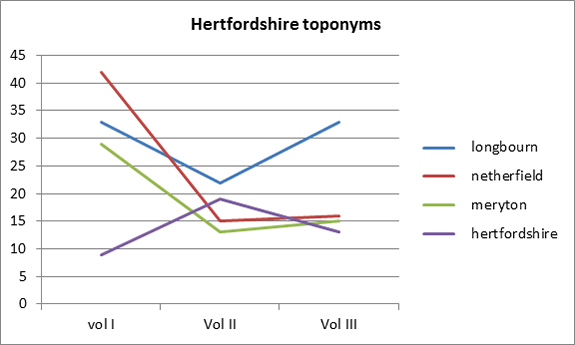
- Graph 3 (Excel): Hertfordshire toponyms
- [click on the picture to enlarge it]
Netherfield Park appears in the very first lines (I.1, 3) [4]. After the famous opening which changes focus from the “universal” to the very local via an indefinite “neighbourhood” within 42 words (I.1, 3), this name does not announce anything prestigious: nether preceding field. Moreover, Mrs Bennet’s first cue announcing that it is “let at last” gives it a temporary status. The two paragraphs before this, however, have established it as a place of desire, as its tenant cannot be other than “a single man in possession of a good fortune […] in want of a wife.” Indeed, all characters go to Netherfield Park in the first volume, which contains more than half of the occurrences of the name (42 out of 73 in the entire text). Jane’s visit is extended by the cold she caught while going there on horseback in bad weather (I.7, 34), Elizabeth joins her, followed by their mother and sisters (I.9, 45). In a crescendo movement, it hosts the third ball of the novel (I.18). As the romance between Bingley and Jane does not materialize, Netherfield becomes in volume II a place of regret and absence. His return to it in the middle of the third volume (III.11, 369) signals his wish for marriage and the text’s happy ending.
Longbourn, the second place to be named, is the family nest, threatened by the entail which deprives the Bennet girls and their mother of the right to reside there after Mr. Bennet’s death (I.13, 69). Austen had already explored the possibilities of a family of women expelled from their home in Sense and Sensibility. In Pride and Prejudice, the entail serves to bring in Collins, the “distant relation” who would take over the house (I.7, 31), halfway through the first volume, with the worthy ambition of marrying one of the Bennet daughters (I.15, 78) but leaving with their friend Charlotte instead (I.22). To foreground the fact that the girls must depart from the paternal roof for the story to develop, Austen only mentions Longbourn after six occurrences of Netherfield and two of London, and then describes it briefly at the end of a sentence about the return of the Bennet girls and their mother from the first ball of the novel as “the village where they lived, and of which they were the principal inhabitants” (I.3, 13), the place to which one comes back, characterised by its limits, albeit flexible (long – bourne i.e. boundaries) [5].
For the young women’s entertainment, another place is needed: “when nothing better offered, a walk to Meryton was necessary to amuse their morning hours and furnish conversation for the evening” (I.7, 31). In Meryton (merry-town), Austen brings in a militia regiment which turns the youngest daughters’ heads and brings in the character of Wickham (I.7, 31). If the occurrences of “Meryton” are found, like those of “Netherfield”, mostly in volume I, Longbourn is named as often in the third volume as in the first, after a decline in the second: even while becoming independent, the Bennet girls do not break loose from the family home, the place most often named (88 times).
Taken as a whole, the occurrences of the names designating Hertfortshire locations or the county itself appear mainly in the first volume but do not vanish from the following ones (44% of the 259 occurrences in volume I, 26% in volume II, 30% in volume III). The name of the county increases in the second volume while specific names decrease in frequency: the area Elizabeth and Jane have temporarily left is evoked as a whole rather than divided into its constituent elements (Hertfordshire rather than Longbourn, Meryton, Netherfield Park), which suggests their growing affective distance from it. The volume opens on the disillusionment of the two elder daughters, as Jane and Bingley’s romance seems doomed while Elizabeth has refused Collins and then learns that Wickham has ambitions for a more lucrative match (II.3). Austen then sends Jane to London, Elizabeth to Kent and Lydia to Brighton (II.3, II.4, II.18).
Their trips first take them south to bad models, then north, a region with mixed connotations. Travelling extensively, the heroine progresses from the primal space to the splendid estate of Pemberley in the respectable north, which will become hers after a detour through Kent. Endowed with less intense emotions, Jane will not go any further than London, while excessive Lydia is sent the furthest south (Brighton) and north (Newcastle).
London:
In most of its 68 occurrences (55 mentions of the name and 13 of streets and areas), London is a welcoming place. The attraction of the capital for the provincial young women comes largely from its being the residence for part of the year of their rich suitors, Bingley and Darcy, and of their sisters. Yet this is not the London the Bennett sisters have access to (II.2, 161). Although Mr Bennett “hates London” (II.6, 186), Elizabeth and Jane are welcome visitors at their aunt and uncle Gardiner’s house in Cheapside, a part of London devoted to trade [6]; Austen plays on the polysemy of the word ‘capital’. As wealthy merchants, the Gardiners can be situated socially between the country-dwelling Hertfordshire side of the family and the upper gentry (the Darcys and the Bingleys). As surrogate parents, they welcome Jane in Volume II and Lydia in Volume III between her elopement with Wickham and their forced marriage. In this late episode, London fulfils its traditional role in fiction as a place of dissimulation and iniquity: if Wickham had intended to marry Lydia, he would have taken her across the Scottish border to Gretna Green so as to escape the Hardwicke Marriage Act, as she announces in the letter she leaves behind (III.4, 303). This double function of London, both positive and negative, explains its increasing presence: 15 occurrences in Volume I, 21 in Volume II with 5 mentions of streets, and 32 in Volume III with 7 mentions of streets (see concordance).
For Elizabeth, the capital is merely a stopping-place: while on her way to the newly-married Collinses, she stays with the Gardiners who invite her to accompany them on “a tour of pleasure which they proposed taking in the summer” (II.4, 174). The geographical horizon of the young woman then widens towards both north and south, as a detour through Kent is necessary for her to accept the values and the hand of her Derbyshire suitor.
Austen encapsulates all the meanings of capital in her use of the adjective for the discussion of the Bennet family by the Bingley circle (London, wealth, and, as an adjective, excellent, often tinged with irony): “’That is capital,’ added her sister, and they both laughed heartily” when Miss Bingley tells of the “uncle who lives somewhere near Cheapside" (I.8, 40). The word is used four times in Pride and Prejudice, always as an adjective. In a corpus made of 34 novels from 1760 to 1830 [7], the use of ‘capital’ as an adjective is as frequent as its use to designate “the city or town that functions as the seat of government and administrative centre of the country of a country or region” (OED - 42 occurrences of each, the town being mainly London); it means wealth in 11 occurrences. The concordance of ‘capital’ in Austen’s six main novels shows that she always used the term as an adjective.
The first user of the adjective in Pride and Prejudice is the narrator, stating that Elizabeth’s “performance [on the pianoforte during the gathering at the Lucases] was pleasing, though by no means capital” (I.6, 27). Yet the value of the superlative degree is undermined by the comparison with Mary’s performance: “Elizabeth, easy and unaffected, had been listened to with much more pleasure, though not playing half so well”. In its third use, “capital” is again linked to music, with a similar irony as Lady Catherine de Bourgh compares her pianoforte to that she imagines the Bennets possess: “Our instrument is a capital one, probably superior to—” (II.6, 185). This has been debunked by her nephew’s reaction earlier during the visit to Rosings: “Mr. Darcy looked a little ashamed of his aunt’s ill-breeding” (II.8, 195). Then, from the other end of the spectrum, silly Lydia taints the word for good when the four sisters meet halfway between Longbourn and London: “It is excellent news—capital news—and about a certain person we all like!” (II.16, 243). Austen gives Lydia’s exciting news proleptic value through Elisabeth’s transformation of her “Wickham is safe” into “And Mary King is safe!": Lydia definitely will not be so herself.
Kent is Collins’s county. Mixing real and fictional toponyms, the letter of the first volume in which he announces his arrival to the Bennett family situates places precisely: only the first place name of the superscription is fictional: “Hunsford, near Westerham, Kent” (I.13, 69). Realism and irony combine to endow places with moral values. In the first volume, the dialogue in which Collins contrasts his “humble abode” with the opulent mansion (I.16) of his protector Lady Catherine de Bourgh enables the reader to relish the comments of the Bennett family while being informed of the social dependence established between the two residences. With her father’s approval, Elizabeth refuses to commit herself to this “self-conceit[ed]” foolish man (I.15, 78). In the second volume, the narrative voice alternates with those of the Collinses to describe their home. The combination of indirect and free indirect discourse sets the way in which Charlotte puts up with the man whom her friend refused:
To work in this garden was one of his most respectable pleasures; and Elizabeth admired the command of countenance with which Charlotte talked of the healthfulness of the exercise, and owned she encouraged it as much as possible [...] When Mr. Collins could be forgotten, there was really an air of great comfort throughout, and by Charlotte’s evident enjoyment of it, Elizabeth supposed he must be often forgotten. (II.5, 177-78)
Collins fragments the perception of place into an accumulation of details which mars the landscape (“Every view was pointed out with a minuteness which left beauty entirely behind”, 177) and reduces Rosing to an “enumeration of the windows in front of the house, and his relation of what the glazing altogether had originally cost Sir Lewis de Bourgh” (II.6, 182). He lacks perspective more than grandiloquence. His obsequiousness combined with Lady Catherine de Bourgh’s pride associate Kent with what the heroine refuses: a marriage of convenience with a fool and the aristocratic pride she despises. As she and the reader judge Lady de Bourgh’s nephew Darcy according to the same standard at this point of the text, his proposal cannot possibly be acceptable. She needs to discover his territory to discard her prejudices. The South thus serves as a stage in the heroine’s development: the names designating Kent dwindle to fewer occurrences in volume III than in volume I (15, 61, 12).
The negative connotations of the South are reinforced by the Brighton episode. The 11 occurrences in volume I and 13 in volume II serve as backdrop to Lydia’s elopement (II.16-18, III.5-6): they evoke the context of Napoleonic wars without naming it but mainly sever Lydia from the positive family values of her elder sisters.
The North is mentioned as such in a number of occurrences comparable to the Brighton references (21 in all). Yet this region is ambivalent from the start, with the opening chapter crudely stating the novel’s underlying argument: how to get money in a respectable way on the marriage market.
- The North and money
- The North and social values
- The North: tourism or banishment?
- The positive North: Derbyshire
The qualification of “a young man of large fortune” suffices for Mrs Bennett, but the reader understands that he has to “rent” Netherfield Park because he does not own an estate, in a society where land-owning was still the main sign of (respectable) wealth. A few pages later, one learns from the ironical narrator that the Bingley fortune comes from trade (I.4, 16), which suggests that the senior Mr Bingley took part successfully in the industrial revolution or, like Mansfield Park’s Sir Thomas Bertram, in the slave trade. Austen uses the connotations of the North and of trade to establish a social hierarchy: Bingley being the heir of a “respectable” family with a “considerable” fortune, his sisters can forget that it comes from “trade” and, “associating with people of rank,” mingle with upper gentry, such as Darcy (I.4, 16). The same terms combine to designate the London uncle, Mr Gardiner, as Mrs Bennet’s “brother settled in London in a respectable line of trade” (I.7, 31), but the Bingley sisters despise the commercial Cheapside where the Gardiners reside. Despite the difference in fortune, the Bingleys, the Gardiners and the Bennets belong to the same social class. Moreover, when Elizabeth defends herself to Lady Catherine de Bourgh, she is famously made to declare “He is a gentleman; I am a gentleman’s daughter; so far we are equal” (III.14, 395). The irony of the narrative voice, distilled throughout the text, establishes the moral difference between the young women of the two families.
The Bingleys associate both with “people of rank” (I.4, 16) and with worthless gentry: one of the sister’s husband “merely looked the gentleman” (I.4, 17). Darcy, introduced in a neutral way as “another young man” brought by Bingley to the Meryton ball (I.3, 10), appears by contrast as the ideal suitor, good-looking and twice as rich as his friend: “his fine, tall person, handsome features, noble mien, and the report which was in general circulation within five minutes after his entrance, of his having ten thousand a year” (I.3, 10). The narrative voice formulates the quick change in the collective female opinion by stating that “not all his large estate in Derbyshire could then save him from having a most forbidding, disagreeable countenance,” while Bingley seems to embody all the requisite qualities of the ideal young man (I.3, 10-11). From the start, Darcy is associated with a more precise location than his friend. Giving the name of the county (Derbyshire), makes it unnecessary to specify that his property is up north, at least in relation to Hertfordshire. While at the beginning of the novel Darcy is “unworthy to be compared with his friend” (I.3, 11), the latter must however “take Pemberley for a kind of model” (I.8, 41) for his future residence. The two male characters first seem to be constructed as foils to one another, but Bingley gradually fades into a mere reflection of Darcy as the latter’s worth appears, in the same manner that Jane is a less lively Elizabeth. Netherfield Park is finally given up for an estate “within thirty miles” of Pemberley, “bought” and not let (III.19, 427).
The North: tourism or banishment?
In the second volume, the North designates the Lake District (6 occurrences), where tourism was beginning to develop in part thanks to Wordsworth’s praise [8]. Elizabeth idealises it somewhat, exclaiming “What are men to rocks and mountains?” (II.4, 174) when the Gardiners propose that she accompanies them on “a tour of pleasure” a few months later to change her mind from the unpleasant experiences with Wickham and Collins. As Michael McKeon notes, the over-determined description of space by Collins mentioned earlier contrasts with this aspiration to a place embodying freedom [9]. The use of the adjective “northern” and the adverb “northwards” for this intended journey shows that it is only a project, a journey which will not take place, or at least not as planned, for, unlike Lydia, the heroine will not go beyond respectable bounds. Indeed, the Gardiners curtail their initial plan and decide “to go no farther northwards than Derbyshire” (II.19, 265), whereas the rebellious pair are “banished to the North” with Wickham’s regiment posted in Newcastle [III.8, 346]. The low number of occurrences (26) and their lack of precision implies that the North is the place where nothing happens, which makes it the ideal place for the couple who do not respect the rules of propriety. Elizabeth, by contrast, achieves the delicate balance between pride and prejudice, gradually learning how to discern the rules which must be followed and those which are better transgressed. She is rewarded by improving her condition and settling in Derbyshire.
The positive North: Derbyshire
In opposition to the northern area where Lydia is exiled, this positive North, represented by Pemberley, acts as a magnet (Bingley ends up buying an estate 30 miles away (III.19, 427). Other terms designating Derbyshire are “Lambton” (the village where the travellers are staying, mentioned 10 times) and the 24 mentions of the name of the county. The third volume contains 62% of the 53 occurrences of “Pemberley”, as is to be expected from the closing sentence of volume II: “To Pemberley, therefore, they were to go.” During her visit of this prestigious estate whose proprietor Elizabeth thinks absent (II.19, 267), she realizes the need to revise her prejudiced views on this suitor, which their encounter in the South had reinforced. While Collins’s praise of the place she could have shared with him leaves her indifferent (II.5), she envisages herself as belonging to Darcy’s environment: “And at that moment she felt that to be mistress of Pemberley might be something!” (III.1, 272) [10]. By discovering the qualities of the estate, she becomes ready to accept those of its owner, illustrating the common wisdom that exterior qualities show interior ones [11]. The perception of the grounds through the windows of the house (III.1, 272) shows the balance between nature and culture, after the excess of both Elizabeth’s idealised view of the Lake District and Collins’s narrow perception of his environment.
3. Motions and Emotions
3.1. Each space in the novel is characterised by a combination of movements. From concordances of toponyms designating the areas examined in “Places & Spaces”, the proportion of movements to, from or within each area show clear differences. TO, FROM and IN should not be taken literally but stand for occurrences of terms in the concordance of an area (Hertfordshire, Kent, Derbyshire, the North) or place (London, Brighton) stating movements to (with phrases such as ‘come to’, ‘return into,’ ‘receive at’), or from it (‘leave’, ‘quit’, ‘a letter from’, …) and situations within it (‘a ball at Netherfield’, ‘walk to Meryton’, …).
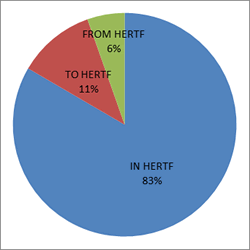
- Graph 4a: Hertfordshire
- [click on the picture to enlarge it]
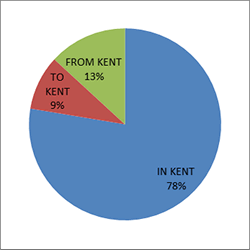
- Graph 4b: Kent
- [click on the picture to enlarge it]
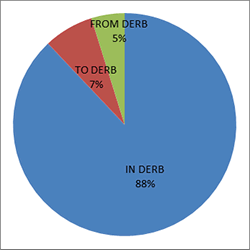
- Graph 4c: Derbyshire
- [click on the picture to enlarge it]
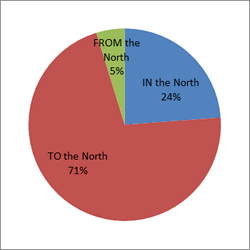
- Graph 4d: The North
- [click on the picture to enlarge it]
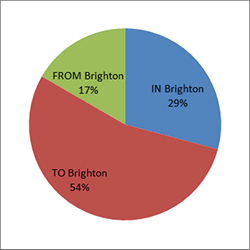
- Graph 4e: Brighton
- [click on the picture to enlarge it]
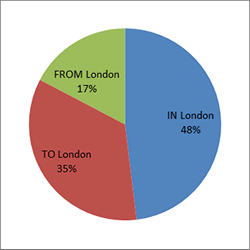
- Graph 4f: London
- [click on the picture to enlarge it]
In the three counties, IN prevails. The range is not very wide but still significant: 83% in Hertfordshire, the family nest and by far the most important area quantitatively [link to Graph 1], with a variation of 5% on either side of it for the two other counties, 78% in Kent, where it is not desirable to stay, and 88% in Derbyshire, the place to be.
The progression from Hertfordshire to Derbyshire marks the movement of the heroine from her father’s abode to that of her husband, with the formative detour through Kent via London, while Lydia who goes further south (Brighton) and north (Newcastle).
The distribution of movements in the two areas much less mentioned, Brighton and the North, show that their main function is to express Lydia’s taste for going further than her sisters (TO prevails). Because the North is a more complex construction than Brighton (as argued in “Places & Spaces”), TO takes its highest value in connection with this ambivalent area, also the initial vague destination of the journey planned by the Gardiners.
FROM is highest in connection to London and Brighton, places of transit, then in Kent, which displeases both heroine and hero. The similarly low proportions of FROM in the North, Hertfordshire and Derbyshire have different causes.
Kent and Derbyshire total the same number of toponyms but the distribution of movements show the different roles of the two counties: Kent is where values are assessed and finally refused, while Derbyshire is where the balance between pride and prejudice is found.
Characters who reside in Hertfordshire mostly do not move from it but within it: events happening IN Hertfordshire for which toponyms are used make up 42% of all movements taken into account (214 between Netherfield, Longbourn and Meryton out of 547 mentions of toponyms). Suitors come to Hertfordshire but do not stay (TO: 13%) and the young women leave it to a lesser extent (FROM: 6%).
Almost a quarter of the movements associated to Kent are journeys, mostly there and back, with FROM (13%) more than twice as high as for the other two counties: the combination of Hunsford and Rosings form an area to get out of, once the challenges it provides for Elizabeth and Darcy have been met.
The heroine and the hero both go to Kent on a visit, stay for some time, interact, then leave separately, dissatisfied with one another after Elizabeth’s refusal of Darcy’s proposal. Elizabeth moreover refuses the norms that prevail with the characters who reside in this county, Collins and Lady Catherine de Bourgh. Leaving it and its values constitutes an important stage in the development of both Elizabeth and Darcy.
The journeys of the Kent characters to Longbourn are also two-way, but short and with a definite purpose: Collins visits the Bennets in the first volume to get a wife from among the Bennet girls and leaves with Charlotte Lucas (this takes three trips: I.13-22, I.23, 146 - II.2, 158; II.3, 164-65), Lady Catherine de Bourgh darts in and out when trying to convince Elizabeth not to marry her nephew, which has the contrary effect (III.14). These two journeys ironically cause the union of Elizabeth and Darcy.
Derbyshire is the place to be, with the highest proportion of IN (88%) and the fewest movements FROM it (5%). TO is also low (7%), as Elizabeth’s journey with the Gardiners was initially planned only “northward” and thus falls into the ‘North’ category. Only in the last chapter of Volume II does Austen focus the journey on Darcy’s territory and thereby brings her unwitting heroine to it: “Elizabeth was excessively disappointed […] It was her business to be pleased […] ‘But surely,’ said she, ‘I may enter his county with impunity’” (II.19, 265). Finishing volume II with “To Pemberley, therefore, they were to go” acts as a strong signal for the reader (II.19, 267). Once there, pride and prejudice turn into positive forces which enable attraction to mature into a respectable and desirable union.
Characters mostly go or speak of going to the North (TO: 71%), but almost nothing takes place there (IN: 24%, the lowest proportion of all areas). Although the Bingley family originates from it (FROM: 5%), they do not go back, or rather, Austen prefers to link the estate which Bingley finally buys to Pemberley (III.19, 427) rather than associating it to ‘the North’, by that stage tainted with Lydia and Wickham’s banishment much further North. Ironically, Newcastle where they end up is as high up North as Gretna Green, where they should have gone had Wickham intended to marry Lydia (54.9833° N latitude).
Being in Brighton is less exciting for Lydia than going there (IN: 29%, TO:54%). Her elopement with Wickham is not really linked in terms of word use to this city (only 4 occurrences) as their final destination is more important.
The status of London as a neutral place of transit is confirmed: what occurs there makes up only half of its mentions (IN: 48%), and it is twice more desirable to go TO London (35%) than FROM it (17%).
3.2. Using space to animate the story also implies positioning characters. To make the hero and the heroine adjust to one another, the narrative voice uses the speed at which they move and the distance they cover. A concordance of “mile” [12] shows how their geographical movements evolve.
In the first volume, in Hertfordshire, distances are covered on foot. The “most convenient distance for the young ladies” is “one mile from [Longbourn] to Meryton” (I.7, 31), a norm which Elizabeth is the only one to transgress by walking the three miles from the family home to Netherfield Park in order to join Jane who went there on horseback (I.7, 34- 35). The state in which she arrives shocks the Bingley sisters and “bewitches” Darcy (I.10, 57), for if they focus on her dirty stockings (I.7, 36) and petticoat (I.8, 39), he sees her eyes “brightened by the exercise” (I.8, 39).
In the second volume, the young women travel. To cover the “twenty-four” miles between Longbourn and London, the travellers need half a day (II.4, 172). The same distance separates London, where they spend the night, from Collins’s abode in Kent, their final destination. The trip back also takes just under “four hours” (II.15, 240). For Darcy however, half a day suffices to cover fifty miles (II.9, 201). This distance enables the narrative voice to confront the objective and subjective perceptions of distances when the hero and heroine discuss Charlotte’s establishment in Kent:
“It must be very agreeable for her to be settled within so easy a distance of her own family and friends.”/ “An easy distance, do you call it? It is nearly fifty miles.”/ “And what is fifty miles of good road? Little more than half a day’s journey. Yes, I call it a very easy distance.”/ “I should never have considered the distance as one of the advantages of the match,” cried Elizabeth. “I should never have said Mrs. Collins was settled near her family.”/ “It is a proof of your own attachment to Hertfordshire.
Anything beyond the very neighbourhood of Longbourn, I suppose, would appear far.” (II.9, 201)
Before he proposes to her, Darcy tries to assess how far a distance Elizabeth would be ready to put between herself and her family, as Pucci argues. [13]
The last occurrence of the second volume shows that a distance of one or two miles remains the scale within which the Bennet family feels comfortable. This is the detour the Gardiners and their niece are ready to accept in order to visit Pemberley (II.19, 266]. Lydia’s exuberance is suggested as she multiplies this tenfold, albeit figuratively, when the three younger sisters meet the two eldest ones halfway between Longbourn and London (II.16, 246). Austen associates this distance with her three times in all; the other two occurrences serve for mistaken views about her: in her letter to Elizabeth, Jane states that the eloping pair “must have passed within ten miles of [Longbourn]” on their way to Scotland (III.4, 302) and Mrs Bennet “could not bear to have her ten miles from [her]” before her husband makes it clear that the couple is not to reside in the vicinity of the family home (III.8, 342). Austen thus indicates that Lydia needs to be put at a distance from the rest of the family.
In the third volume, the area in which Elizabeth moves increases: if the walk to Pemberley “gradually ascend[s] for half-a-mile” (III.1, 271), the park has a ten-mile circumference, which makes “going round the whole park […] beyond a walk” (III.1, 280). Austen’s purpose in using this greater unit of measurement becomes apparent when one realises that the radius of such a circumference is I.6 miles, half of the distance walked by Elizabeth from Longbourn to Netherfield Park. A factor of ten also serves for the distance between Pemberley and the estate finally bought by Bingley (III.19, 427): the three miles of the first volume become thirty. The improvement of the two elder sisters’ social condition gives them access to a greater scale of both distances and values, without banishing them from respectable bounds like the youngest, who is sent further south and considerably further north.
In Pemberley, even small distances are expressed in miles, with a comic effect: the double division of “half a quarter of a mile” during the walk in the park suggests benevolent proximity between the heroine and her chaperones (III.1, 284), the guided autonomy granted to the main character by leaving 220 hundred yards between the new couple and the established older one, whose female half opportunely claims to be weary. The only occurrence of a smaller unit serves to put Elizabeth and Darcy uncomfortably close to one another in their surprise encounter at Pemberley: “they were within twenty yards of each other” (this is the only occurrence of “yard”: III.1, 278).
4. Range and Scale
Pride & Prejudice takes place within the eighth of a mile in Pemberley and the 350 miles between Brighton and Newcastle covered by Lydia, with the 120 miles between Longbourn and Pemberley as the appropriate distance [14]. Austen is not concerned with the actual travelling but merely marks out the itinerary:
It is not the object of this work to give a description of Derbyshire, nor of any of the remarkable places through which their route thither lay; Oxford, Blenheim, Warwick, Kenelworth, Birmingham, &. are sufficiently known. A small part of Derbyshire is all the present concern. (II.19, 266) [15]
She famously claimed that her scale was a “little bit (two Inches wide) of Ivory.” [16] Indeed she excels in details, in walks rather than trips, in positioning characters in respect to one another rather than in describing the ground they cover. When Elizabeth does not yet belong to the society formed around Bingley in Netherfield Park, she is “left […] to walk by herself” as the path is too narrow for four people abreast and she watches the two Bingley sisters locking arms with Darcy from the position of the ironical spectator: “You are charmingly group’d, and appear to uncommon advantage. The picturesque would be spoilt by admitting a fourth” (I.10, 58) [17]. On Darcy’s territory, their pace adjusts and they walk side by side (III.1, 283), then cover long distances around Longbourn, first “boldly” (III.16, 405) then unwittingly encouraged by her mother (III.17, 415) before they settle in Pemberley.

